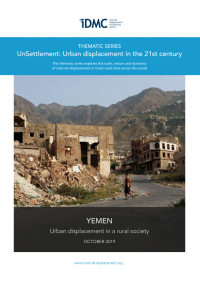UnSettlement: Urban displacement in the 21st century – Yemen: Urban displacement in a rural society
KEY MESSAGES
War and displacement in Yemen are not primarily urban in nature. Despite the amount of media attention given to key urban battles such as the siege of Taiz and the battle for Hodeidah, the disaggregation of data on incidents of conflict and displacement by type of location shows that 68 per cent of the former and 69 per cent of the latter take place in rural areas. This is in line with the rural nature of the country’s population.
Rural to rural and urban to urban displacement are the dominant patterns of movement. The importance of having social networks in areas of displacement and transferable education and skills cannot be overemphasised. The war has also rendered typical pull factors to cities, such as access to basic services and livelihood opportunities, all but irrelevant, meaning that rural to urban displacement is not as common as it might otherwise have been.
Despite the impacts of war, internally displaced people (IDPs) in urban areas still have better access to basic services than their rural counterparts.
Access to water and electricity was poor in urban areas before the war, and even worse in rural areas. The war has only widened such gaps across sectors and the country as a whole. Rural inhabitants, including IDPs, are forced to travel long distances to access markets and health and education services, a costly and time-consuming endeavour that urban IDPs do not face.
Understanding pre-war trends, particularly the decline of rural life and the spread of informal settlements on urban peripheries, will be key in developing solutions to displacement. Urban IDPs join the ranks of the broader urban poor, living in areas where water and electricity supplies and sanitation are all but absent. Deteriorating rural conditions led to rural to urban migration before the war, and this is certain to increase as the conflict aggravates rural decline and leaves IDPs from rural areas nowhere to return to. Developing tailored local solutions that include the integration of urban IDPs into the urban economy will help mitigate the impacts of displacement on individuals and the urban ecosystem as a whole.
https://reliefweb.int/sites/reliefweb.int/files/resources/201910-urban-yemen%20updated.pdf

